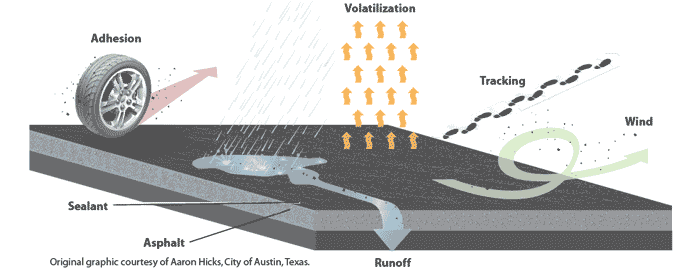Sweeping Industry News Bulletin |
Coal Tar-Based Pavement Sealcoat, Polycyclic Aromatic Hydrocarbons (PAHs), and Environmental HealthSeveral PAHs are suspected human carcinogens and are toxic to aquatic life.USGS – March 23, 2011 Studies by the U.S. Geological Survey (USGS) have identified coal-tar-based sealcoat – the black, viscous liquid sprayed or painted on asphalt pavement such as parking lots – as a major source of polycyclic aromatic hydrocarbon (PAH) contamination in urban areas for large parts of the nation. 
Key Findings from USGS Studies
Polycyclic aromatic hydrocarbons, or PAHs, are a group of organic compounds composed of fused benzene rings. PAHs occur naturally in crude oil, coal, and tar, and are produced by the incomplete combustion of fossil fuels and biomass (wood, grass, tobacco). They are widely distributed in the environment and are of concern because they are toxic, mutagenic, teratogenic, and several are probable human carcinogens. Pavement sealcoat (also called sealant) is a black liquid that is sprayed or painted on asphalt parking lots and driveways. It is marketed as protecting and beautifying the asphalt pavement. Sealcoat is used commercially and by homeowners across the Nation. It is applied to residential driveways, playgrounds, and parking lots associated with commercial businesses, apartment and condominium complexes, churches, schools, and business parks. Most sealcoat products have a coal-tar-pitch or asphalt base. Coal-tar-based sealcoat is commonly used in the central, southern, and eastern U.S.; asphalt-based sealcoat is commonly used in the western U.S. Coal-tar pitch can contain 50 percent or more PAHs by weight and is known to cause cancer in humans (International Agency for Research on Cancer, 1985). Coal-tar-based sealcoat products typically are 20 to 35 percent coal-tar pitch. Product analyses indicate that coal-tar-based sealcoat products contain about 1,000 times more PAHs than sealcoat products with an asphalt base. To view information on this topic in its entirety on the USGS "Texas Water Science Center" website, click here. The site includes a link to the latest seal coat fax sheet. We also have the latter archived here on the WorldSweeper site.
For additional information contact: If you have a question or comment about this information, please let us know. If appropriate, we'll add it to the bottom of this page. |
© 2005 - 2021
|
Industry Updates Contents
|